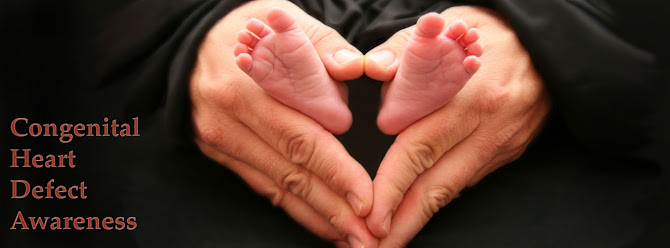
What a month it has been! It's hard to imagine that only a month and a half ago, I found out for the first time that Feb. 14 was the official "CHD Awareness Day," and that Feb. 7-14 was "CHD Awareness Week." One month ago I decided to start this little attempt at educating myself, and along the way maybe a few friends and family members, about the issues facing CHD families and survivors today.
Today I'm a bit emotional about this whole thing. I have met a wide variety of new people through this blog - adult CHD survivors who are worried about finding adequate health care and professionals experienced with adult CHD issues; parents of children who have been lost due to CHD; a teenager on a crusade not to "be a freak" anymore; and bunch of parents who share the same concerns I do, and who are ready and willing to step up to the plate and find ways to work together to get the word out to our government and the public at large. It's been an overwhelming, inspiring, sometimes heartbreaking, joyful, somber and overly intense month.
I've debated what to do with this blog... continue? Let it go? I added some analytics to watch the number of page views per day, and I'm surprised at how many of you have hung in there, who read regularly and who continue to come back. Thank you!
Better yet, the blog is coming up in web searches more and more frequently! This is great news to me, personally. When I was in the hospital while my daughter, Sadie, was fighting for her life, I sought the Web relentlessly for links to groups, people and answers about TGA (her specific diagnosis) and heart defects. I never thought to look for Congenital Heart Defects, and missed out on the support I could have found through that avenue. In fact, my doctors never even mentioned CHD as her diagnosis. Hopefully a few other parents new to the diagnosis will stumble across this site and find the links they need for support, facts and answers.
To answer my own question about what to do with this blog, I finally came to the decision that though it will be work, I'd like to keep the blog going. But in order to do it, I'll need to find new data sources, keep abreast of the news, share new stories and insights and get input on future directions. One month of entries was a huge task to take on. I won't be as regular, that's for sure! I guess what I'm trying to say is, that your help is appreciated and needed - if you stumble across items of interest, stories you'd like to share, newly published facts, articles, etc., I would love to share it with this reading community!
To all who have come and visited, and all of you who will continue to, thank you. I wish you and your families much health and happiness in the year to come!
Best wishes,
Kim, mom to Katie (5, HH) and Sadie (17 months, TGA, ASD, VSD)























